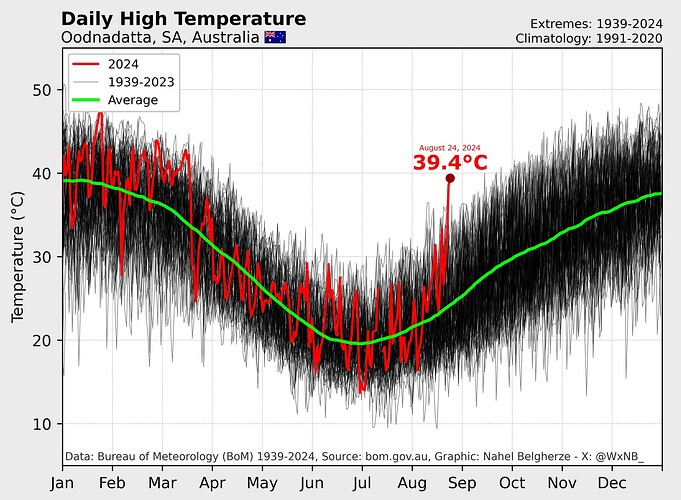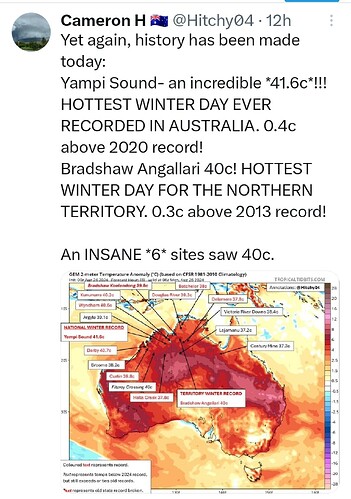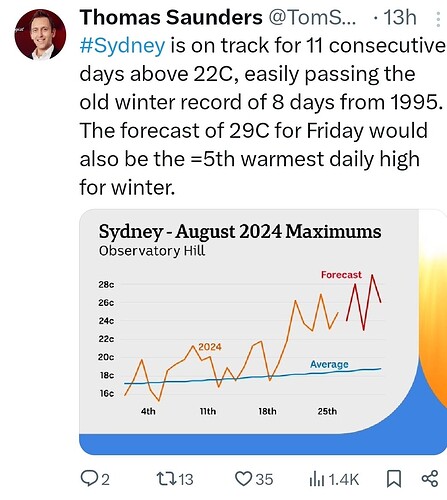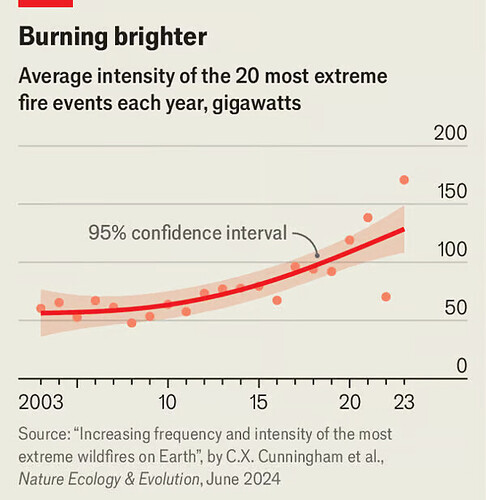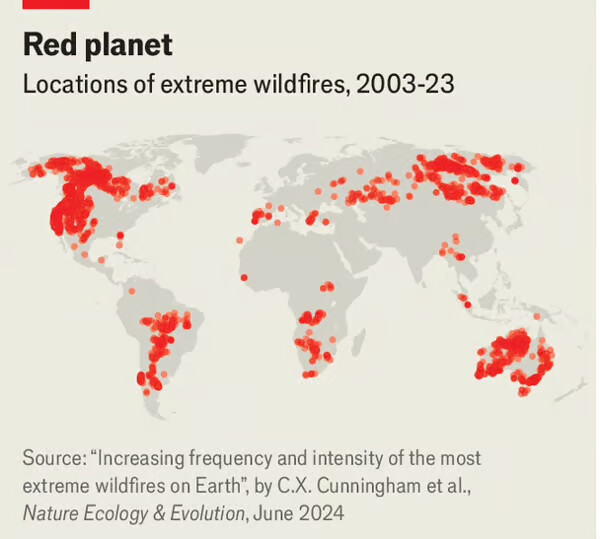Microsoft is building a huge service centre in Braybrook which could consume significant electricity ( as do the ones in Silicon Valley).
I hope they haven’t been cut a special electricity price deal to set up here.
( like the Portland aluminium deal in the past).
And certainly shouldn’t be considered if they’re playing shonky with their income tax.
All five states, huh?
recorded history being the key term here.
In history it has been hotter.
Yes it’s been hotter than it is now , several times in fact, but very key point here is when it was hotter, life on this planet was very different.
History is recorded history
Non-recorded history is NOT history. What happened in pre-history can only be discovered by science.
The same science that has been telling us since the 19th century that CO2 is a greenhouse gas and that its emissions since the Industrial Revolution are causing global warming and unprecedented climate change.
The IAEA has published a summary of the pros and cons of SMRs against the large NPPs.
Among its advantages, faster construction times, less water needed. However, they generate more waste. Additionally, the same scientific rigour on safety.
This is interesting. Some ready made CC technologies that can apply in Australia.
It gives me some hope for my kids future.
Startups are finding novel ways to recycle carbon
Demand is set to rocket as costs continue to fall

Photograph: Alamy
Aug 15th 2024|NEW YORK
In a suburban car park near Seattle Bill Gates recently posed for an unusual photo shoot. Sporting a high-vis jacket and safety boots, the billionaire philanthropist shovelled asphalt from a wheelbarrow into a pothole. Mr Gates was there to tout his investment in a company involved in “carbon utilisation”, a neglected area of climate tech that is heating up.
Capturing carbon dioxide (CO2) from the air will be a crucial part of efforts to slow climate change. Many projects envisage piping the gas to some form of permanent storage (such as salt caverns). Oil companies, which have experience of pumping CO2 into dwindling wells in order to enhance oil recovery, claim to be keen. But less attention has been paid to the many other commercial possibilities. In the group of technologies referred to as carbon capture, utilisation and storage (CCUS), utilisation often gets short shrift.

Photograph: Gates Ventures Photo
The asphalt Mr Gates was shovelling was made by Modern Hydrogen, a startup which has raised some $100m from investors. It has developed a compact pyrolysis reactor that can convert methane (from natural gas, say, or from manure) into pure hydrogen fuel and solid carbon. It has already demonstrated the viability of the hydrogen fuel to a power utility and is now scaling up production. Because its kit can fit inside a shipping container, it reckons this will allow customers far from pipelines to have easy access to clean hydrogen on demand. The solid carbon, meanwhile, is now replacing bitumen distilled from crude oil in asphalt for paying customers, which Tony Pan, its co-founder, calls a “high-value application”.
CarbonFree, another startup which counts BP, an oil giant, among its investors, announced a 20-year deal in April to monetise carbon emissions at a US Steel facility in Indiana. The startup plans to invest $150m to deploy its proprietary technology at the mill. This uses calcium extracted from slag (a traditional waste product) and combines it with CO2 captured from blast-furnace gas to make high-quality calcium carbonate, which the startup plans to sell as a food ingredient.
Martin Keighley, CarbonFree’s boss, insists his firm’s technology is profitable without subsidies. Still, government support helps. Dow, an American chemicals firm, has won up to $95m in government funding to build a facility that will capture some 100,000 tonnes of CO2 a year, which it will use to produce electrolyte solutions for lithium-ion batteries.
ArcelorMittal, a European steel colossus, has built a €200m ($220m) carbon-utilisation plant at a steelworks in the city of Ghent in Belgium. The facility relies on novel equipment made by LanzaTech, a biotech firm based in Illinois, which uses a biocatalyst to turn the carbon-rich waste gas from the blast furnaces into ethanol. This can then be used to make sustainable aviation fuel or chemicals.
In 2022 LanzaTech secured $500m in funding from Brookfield, a Canadian asset manager, to scale up its business. Recently it was jointly awarded up to $200m by America’s Department of Energy to convert CO2 captured at a petrochemical plant into ethylene, a useful feedstock. Jennifer Holmgren, LanzaTech’s boss, reckons replacing “fossil carbon” in supply chains is “a $1trn addressable market”.
The International Energy Agency (IEA), an official forecaster, reckons some 230 megatonnes of CO2 are used in industrial applications each year, mainly for pumping into oil wells and as an input for fertiliser. But the IEA sees other uses such as synthetic fuels, chemicals and building materials “gaining momentum”. It estimates that the current global pipeline of utilisation projects would allow nearly 15 megatonnes of CO2 to be captured for these uses by 2030.
That may not sound like much compared with the 37 gigatonnes of CO2 emitted globally last year. But the opportunity will grow as the cost of capturing and recycling carbon continues to fall. In a report published earlier this year, BCG, a consultancy, and the Oil and Gas Climate Initiative (OGCI), a trade body, estimate that between 430 and 840 megatonnes a year of captured CO2 could be used in industrial applications by 2040. MarketsandMarkets, a research firm, predicts that the global carbon-utilisation market will grow in value from roughly $3bn in 2023 to some $13bn by 2030. BCG suggests this could rise to as much as $50bn by 2040.
A report published on August 7th by America’s National Academies of Sciences, Engineering and Medicine, a group of research bodies, examines the role that carbon utilisation could play in decarbonising the economy. Its boffins conclude that by 2050 “the conversion of CO2 into marketable products…can operate at a global annual scale of multiple gigatonnes to provide an alternative, circular-carbon feedstock.” That would certainly be worth picking up a shovel for. ■
Dhahran, Saudi Arabia recorded a heat index of 134°F (56.7°C) at midnight tonight.
This is near the upper limit of human survivability.
https://x.com/US_Stormwatch/status/1826793539487105340?t=m_maUBzv1-V3DV_MtkVojg&s=19
31 degree dew point . Yikes.
invest in Cooper Pedy real estate
I did a 3 month stint in Coober Pedy a while back and the cool temperature underground is the only good thing that shithole has going for it. ![]()
36.4 degrees there today. Oodnadatta smashing the SA winter record temperature by 3 degrees with an unbelievable 38.3.
Bugger
Oodnadatta broke the all-time Winter record for SA again yesterday. Eighteen degrees above the average. Impressive!
Utilisation seems a good path.
Sydney’s winter, for the most part, felt closer to normal with some quite cold days but things have really taken a turn. I made sure I enjoyed the cold after not really having a winter last year. I am now wondering what spring and summer will bring.
summary
uh oh
article in The Economist
Wildfires are getting more frequent and more devastating
Climate change is accelerating the blaze

Photograph: Getty Images
Aug 22nd 2024
HUMANITY HAS lived and played with fire for at least 300,000 years. The oldest hearth, discovered at Qesem Cave in Israel and thick with wood ash, is as old as ■■■■ sapiens. Burning never subsequently went out of fashion. Millennia later, the large-scale combustion of coal, oil and natural gas unlocked energy on a scale far beyond the hearth—and in so doing set in train profound changes to the planet’s climate. Humankind, activists are fond of saying, set fossil fuels alight and the world with it. They brandish placards with images of a burning blue marble.
They have a point. Wildfires are more than a powerful visual metaphor for climate change. Data show they are increasingly fuelled by the extreme conditions resulting from greenhouse-gas emissions. What is more, some researchers believe that they are helping drive climate change themselves, powering feedback loops with destructive consequences for human health and ecological stability.
The past five years have been marked by a sequence of particularly extreme wildfires. In late 2019 and early 2020 the “Black Summer” bushfires burned through 23% of south-eastern Australia’s temperate forests. While New South Wales burned, Siberia smouldered, as fires from the previous summer simmered beneath the snow, re-emerging to lay waste to an area bigger than Britain. In 2021 a persistent heat dome over North America’s Pacific north-west produced perfect conditions for widespread burns which would have taxed firefighters even if they had not been synchronised. The day after temperatures in the Canadian town of Lytton soared to a record-breaking 49.6°C, Lytton was no more. In 2022 more of the European Union went up in flames than in any year since 2000, bar one. The next year, more than 950 square kilometres burned near the Greek city of Alexandroupoli in the EU’s largest single wildfire since the 1980s.
The most remarkable blazes of the century, though, engulfed much of Canada between March and October 2023. Thousands of individual fires, many of them out of control for weeks or months at a time, set records for both their size and the speed at which they spread. No region was spared, from the Atlantic coast to the Pacific and from the southern border to the Arctic’s Beaufort Sea. The fires burned more than 180,000 square kilometres, nearly seven times the average burn area in recent years; 232,000 people were evacuated. Cumulatively, they produced almost 1,800m tonnes of carbon dioxide: three times Canada’s industrial greenhouse-gas emissions that year.

Chart: The Economist
According to a study of extreme fire events published in June in the journal Nature Ecology & Evolution, the years since 2018 have been six of the seven worst since 2003. Over the same time-span the total amount of heat given off by the 20 worst fires of any given year has more than doubled. Noting that global warming was long claimed to be leading to more extreme fires, the authors say there is now evidence to show that this trend is real (see chart).
“Attribution” studies look for the links between these events and global warming that common sense suggests must be there. They use climate models to determine whether specific events were made worse or more likely by climate change. The conclusions are stark. Australia’s Black Summer fires were made at least 30% more likely. The record-breaking spring heatwave that revived the Siberian fires of 2020 would have been “almost impossible” in a world without climate change, according to World Weather Attribution, an international modelling collaboration. As for the Canadian heat of June 2023, an international team of academics concluded in August that its occurrence was about three times more likely under global warming than it would otherwise have been.
Once burned, twice burned
Drier periods and hotter weather often combine to create the ideal conditions for large, destructive fires: tinder-dry vegetation ready to burn, and a paucity of fire-dousing rain. (That said, in some regions some rains can do damage by overabundance—providing more plant mass for dry seasons to turn to fuel.) Climate change means “fire weather” is not only becoming more frequent but also more geographically widespread.
Globally, fire seasons lengthened by 14 days (or 27%) between 1979 and 2019, according to research published in 2022 in Reviews of Geophysics, a journal. The number of days when the most extreme fire conditions prevailed increased by 54%, or ten additional days, over the same period. The Mediterranean, the Amazon and the Pacific forests of North America are among the regions to have seen the greatest increases.
More fire weather does not in itself mean more fires. Roughly 70% of the land surface that burns each year is in Africa, most of it savannahs that are deliberately set alight to regenerate grazing lands and make way for agriculture. These burns are decreasing, in part because people are setting fewer of them and in part because climate change is moistening some savannahs. These changes are leading to a lower total burn area, to the delight of climate sceptics. Remove this vast area from the data, though, and a very different trend emerges: forest fires are on the rise, particularly in the boreal regions that encircle the Arctic. In boreal North America, for example, the burned area doubled between the 1960s and the 1990s.
The pattern is ongoing and global, says Matthew Jones, a researcher at Britain’s Tyndall Centre for Climate Change Research, who has published a new paper in Earth System Science Data, a journal, showing a clear increasing trend in forest wildfires globally. His collaborator Stefan Doerr, the director of the Centre for Wildfire Research at Swansea University, calls it “basically beyond question”. The distinction between savannah fires and forest fires matters: grasslands regenerate within a few years. Forests, particularly old-growth ones, take decades to grow again.

Map: The Economist
The study shows that the increase is particularly marked in the boreal forests that encircle the Arctic. Last year’s megafires in Canada fall into this category, as do the Siberian blazes of 2020. This has implications for future warming. In tropical savannahs, new plant growth fairly quickly absorbs carbon dioxide—that which was emitted in last year’s fires is soon reabsorbed. When mature forests go up in flames, reabsorption can take many decades or even centuries. Thus boreal fires significantly raise carbon dioxide levels.
The picture may not be as bleak as it seems. In some boreal regions, like parts of North America, burned conifer forests are being replaced by deciduous trees, which grow—and therefore suck carbon out of the atmosphere—faster. This could help mitigate warming rather than amplify it, says Dr Doerr, but it is most probably a minor buffer. (Elsewhere, the dynamics are different: deforestation of the Amazon threatens to turn that ecosystem into a carbon-poor grassland, a process that is accelerated and sustained by wildfires.)
There is another complicating factor. In the winter, boreal forests look dark from above, because the season’s snow sits below the canopy of leaves. Clear the forest and the snow is revealed to the sky; and reflecting sunlight, rather than absorbing it in a leafy canopy, cools the planet. Though boreal-forest fires heat things up immediately, by spreading ash and depriving forests of the cooling effect of transpiration (the evaporation of water from the leaves of trees), over the decades that follow boreal-forest fires increase the amount of snow bared to the sky. That cooling effect is widely taken to outweigh the warming driven by the fires’ direct emissions.
This effect is on the wane. For one thing, snow cover is decreasing as the world warms. That means the strongest cooling effects are becoming restricted to more and more northerly forests. For another, as fires get more intense, their emissions, which may already be underestimated, could significantly increase.
The unfrozen North
Another huge unknown in the spread of fires to the boreal regions is peat. Peat is a type of soil formed over thousands of years that is exceptionally rich in carbon. The carbon emissions produced when peatlands burn may be well nigh irreversible. Worryingly, most of the world’s peat is found on the fringes of the Arctic, precisely where wildfires are on the rise. Though peatlands are often waterlogged and, at high latitudes, frozen, heat and drought could overcome these fire protections.

Too hot to handlePhotograph: Panos Pictures/ Matthew Abbott
Peat burning in boreal regions is probably one of the biggest sources of uncertainty about future fire emissions, says Dr Doerr. Though the Arctic is now warming nearly four times faster than the global average, how much of the boreal peat will burn—and when—is impossible to predict. The likelihood of such fires starting, though, looks set to increase. Most fires in boreal regions are ignited by a bolt of lightning (unlike fires elsewhere, which are often started by humans). And forests in temperate and boreal regions could see an 11-31% increase in lightning strikes for every degree of warming, according to a study published last year.
The climate impact of blazes that burn peat, among other things, has led some to propose the active suppression of such fires as a way to mitigate emissions. This is a departure from the norm: most countries try to conserve resources by tackling only the blazes that directly threaten human safety or property. (It also runs against the “let burn” firefighting orthodoxy, which favours leaving fires alone in order to reduce the available fuel.)
It would not be cheap. Modelling published in 2022 by researchers from America’s Union of Concerned Scientists and the Woodwell Climate Research Centre in Massachusetts predicted that keeping Alaska’s boreal-wildfire emissions close to the historical average would cost almost $700m a year until 2030, more than five times the state’s current firefighting budget. But, they concluded, per ton of carbon dioxide saved it might well be cheaper than several alternatives currently funded by the American government.
Some have been inspired. As of 2023, the Yukon National Wildlife Refuge—an area of eastern Alaska roughly the size of Denmark—is testing a scheme based on this research. Alaskan firefighters can now be sent to try to contain some types of fires in a specific part of the refuge with the oldest and most carbon-rich permafrost. Jimmy Fox, who manages the refuge for the government, reckons it will mean a couple of big fires are suppressed each year.
Elsewhere, fires continue to go unchecked. After the blazes in Siberia and Russia’s Far East in 2019, the government declared that it would suppress fires across much greater areas. But such promises are useless without the resources to back them up. According to Greenpeace Russia, which monitors wildfires in the country, Russia’s firefighting budget has risen by less than inflation in recent years.
Regardless of the long-term effects of boreal fires on greenhouse-gas levels, some kinds of emissions from combustion have particular economic importance: those from trees that are being credited with locking away carbon in some sort of carbon-credit scheme.
In recent years forestry projects have emerged as a popular source of carbon credits, the idea being that planting new trees—or stopping the destruction of existing ones—can help offset emissions elsewhere. Obviously, those credits are worthless if the vegetation involved goes up in flames, or if the forests’ carbon stock is otherwise depleted (by disease, say, or pests). Consequently, offset schemes rely on “buffer pools” as built-in insurance mechanisms, with any damage compensated for by retiring an equivalent amount of carbon stock from the buffer pool.
Increasingly devastating fires threaten the integrity of these schemes. Take, as an example, California’s state-run carbon offsets programme, which was supposed to guarantee carbon storage for 100 years. An analysis of the programme published in the journal Frontiers in Forests and Global Change in 2022 found that 95% of the buffer pool set aside to mitigate wildfire risk was used up in the first ten years of the scheme’s operation.
Up in smoke
It is not only carbon markets that are at risk. Many national and regional strategies to mitigate greenhouse-gas emissions include plans to reduce emissions by boosting land-based carbon sinks through forestry and agricultural programmes. Fire adds to the reasons for rethinking this.
Such problems will get only worse. Modelling studies suggest that the length of fire seasons will continue to increase as temperatures rise. If the planet warms by no more than the 1.5-2°C temperature range agreed in the UN Paris agreement, the number of extreme-fire-risk days is projected to more than double. Between 3°C and 4°C, they might quadruple. Existing climate policies are currently predicted to stabilise global warming somewhere between 2.2°C and 3.4°C.
With that level of warming, a great many forests, from Alaska to Indonesia and south-east Australia, will experience fire seasons of unprecedented ferocity and duration. ■■■■ sapiens may not have started the fire, but will need to find ways of living with it. And fast. ■


